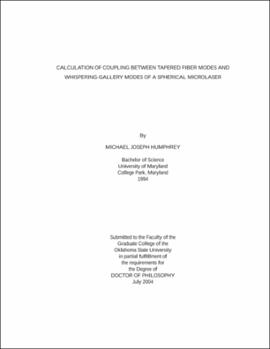| dc.contributor.advisor | Bandy, Donna K. | |
| dc.contributor.author | Humphrey, Michael Joseph | |
| dc.date.accessioned | 2013-11-26T08:26:33Z | |
| dc.date.available | 2013-11-26T08:26:33Z | |
| dc.date.issued | 2004-07 | |
| dc.identifier.uri | https://hdl.handle.net/11244/6897 | |
| dc.description.abstract | Scope and Method of Study: Coupled-mode theory is used to numerically calculate the coupling coefficients between modes of a tapered fiber and those of a fused-silica microsphere. The coupling coefficients are used to determine the optimal fiber taper radius. They are also used to calculate whispering-gallery mode spectra that take into account the eccentricity of the microsphere and the fact that in an experiment the tapered fiber is not necessarily perfectly aligned with the equatorial plane of the microsphere. The spectra are used to model multimode lasing in a microsphere. | |
| dc.description.abstract | Findings and Conclusions: The calculations of optimal fiber radii indicate that the highest coupling from a fundamental fiber mode to a sphere mode is achieved with a fiber that has a radius somewhat smaller (about 30%) than for perfect phase matching. For fibers of this size, the coupling is about twice as strong as when phase-matched. Another advantage of using the smaller sizes is that losses to higher-order fiber modes is substantial for phase-matched sizes. Also, the calculations indicate that coupling to the microsphere TE modes is stronger than to the TM modes. This is a result of the longitudinal field overlap present when coupling into TM modes. | |
| dc.description.abstract | The calculation of WGM spectra shows that there are many possible modes that can be coupled within one free-spectral range of the microsphere. The calculated values of the coupling coefficients are consistent with experimental data. With the fiber laterally offset from, but still parallel to the equatorial plane of the microsphere, the coupling to the fundamental polar mode is not as strong as to some of the higher-order polar modes. This is in agreement with experimental data and is a result of higher-order polar modes having more polar extent. The inclusion of eccentricity and lateral offset enables the numerical calculations to be directly compared to experiment. These calculations are then valuable both for designing experiments and interpreting the resulting data. | |
| dc.description.abstract | The WGM spectra have been used to develop a laser model for a coated microsphere. Nonlinear threshold behavior is found by including the effects of mode competition. | |
| dc.format | application/pdf | |
| dc.language | en_US | |
| dc.rights | Copyright is held by the author who has granted the Oklahoma State University Library the non-exclusive right to share this material in its institutional repository. Contact Digital Library Services at lib-dls@okstate.edu or 405-744-9161 for the permission policy on the use, reproduction or distribution of this material. | |
| dc.title | Calculation of coupling between tapered fiber modes and whispering-gallery modes of a spherical microlaser | |
| dc.contributor.committeeMember | Rosenberger, Albert T. | |
| dc.contributor.committeeMember | Westhaus, Paul A. | |
| dc.contributor.committeeMember | Adams, Don H. | |
| osu.filename | Humphrey_okstate_0664D_1077.pdf | |
| osu.accesstype | Open Access | |
| dc.type.genre | Dissertation | |
| dc.type.material | Text | |
| dc.subject.keywords | tapered fiber | |
| dc.subject.keywords | whispering-gallery modes | |
| dc.subject.keywords | microlaser | |
| thesis.degree.discipline | Physics | |
| thesis.degree.grantor | Oklahoma State University | |
